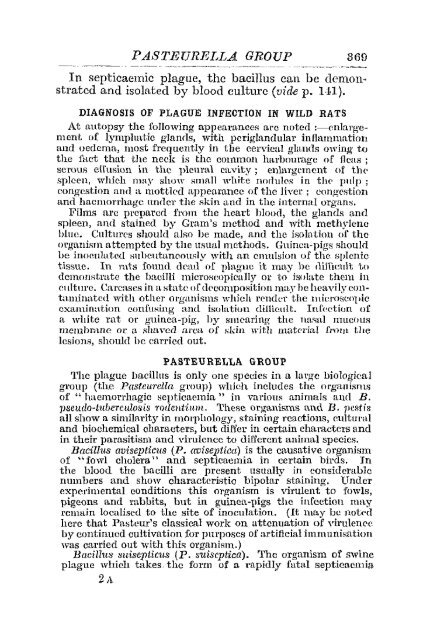AGf~ICULTURAL RESEARCH, PUSA.
AGf~ICULTURAL RESEARCH, PUSA.
AGf~ICULTURAL RESEARCH, PUSA.
Create successful ePaper yourself
Turn your PDF publications into a flip-book with our unique Google optimized e-Paper software.
PASTEURELLA GROUP 369<br />
In septicaemic plague, thc bacillus can be demonstrated<br />
and isolated by blood culture (vide p. 141).<br />
DIAGNOSIS OF PLAGUE INFECTION IN WILD RATS<br />
At autopsy the following appearances are noted :-enlargement<br />
of lymphatic glamls, with pcriglanclular inflammation<br />
and uedema, most frequently in tlle cervical glands owing to<br />
the fad that the neck is thc common hal'bourage of Hcas ;<br />
sel'lms effusion in the pleural en.vity; enlargement of tIl{'<br />
spleen, 'which mny show small white nnclules in tIl(' pulp;<br />
congestion and a mottlc'd appearance of the liver; congl'stion<br />
and haelllorrhage lImIer the skin and in the internal organs.<br />
Films arc prcparcd from the hcart blood, the glanfls and<br />
spleen, and stained by Gram's method and with methylene<br />
blue. Cultures should also be made, and the isolation of the<br />
organism attempted by the usual methods. Guinea-pigs should<br />
be inoculuted suhcutaneously with an emulsion of the splenic<br />
tissue. In rats found dCllU of plague it may he r1il1lelllt to<br />
demonstrate the bacilli microscopically or to isoj[Lte them in<br />
011Itu1'c. earcases in a st.atc of liecomposition nmy he heavily COlltaminatc!l<br />
with othcr organisms whielt l'cnder the miel'oseol>ic<br />
cxamiu(ttion eon fusing and isolation dilllctllt.. InfectiOIl of<br />
a white rat or guinea-pig, hy SIlle-firing the nasnl mucous<br />
Jnclllbrane Or a shaved area of skin with materirtl [rom the<br />
lesions, should be carried out.<br />
PASTEURELLA GROUP<br />
'rhe plague bacillus is only one speeies in a large biological<br />
group (the Pasteurella group) which includes the organisms<br />
of "haemorrhagic septicaemia" in various animals aIlcl B.<br />
psetll[o-lulJerculosis ,·otlcntillllt. These orga.ni.sms :lud B. pestis<br />
all show a similarity in morphology, staining reactions, cultural<br />
and biochemical characters, but differ: in certain characters and<br />
in their parasitism and virulence to different animal species.<br />
Bacillus (lvisepi'icu8 (P. aviseptica) is the causative organism<br />
of "fo'wI cholera" and septicaemia in certain birds. In<br />
the blood the bacilli are present usually in considerable<br />
numbers and show characteristic bipolar staining. Under<br />
experimental conditions this organism is virulent to fowls,<br />
pigeons and rabbits, but in guinea-pigs the i.nfection may<br />
remain localised to the site of inoculation. (It may be not('d<br />
here that Pasteur's classical work on attenuation of virulence<br />
by continued cultivation for purposes of artificial immunisation<br />
was carried out with this organism.)<br />
Badllus 8uiseptict!8 (F. 8uiscpt'ica). The organism of swine<br />
plague which takes thc form of !1 rapidly fatal septicaemia<br />
2A.

















